702 14th Ave E
Samuel Hedges House
Built: 1904
Home of Seattle's Builder of Big Things, Designed by Seattle's Designer of Big Things
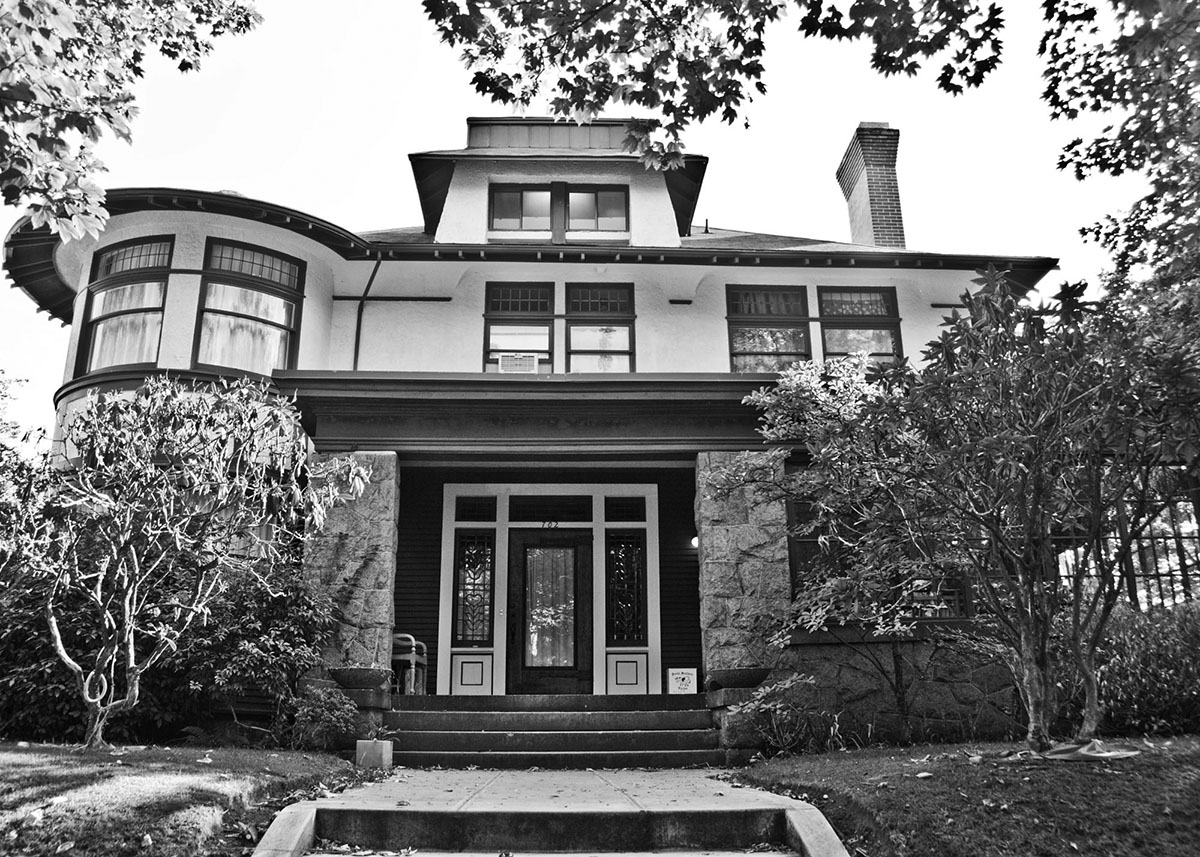
- Style: Mission Revival
- Architect: Graham & Bodley
- Builder: Timothy M. Ryan
Description
This 2 ½ story Mission-Revival style house was designed by architects John Graham, Sr., and Alfred Bodley. The original building permit (#29228, August 15, 1904) allowed builder Timothy M. Ryan to construct this 50'x38' home at a cost of $8,000. The lower story of the house is constructed of irregularly shaped stone and wood shingle. The upper story dormer facing the street is clad in stucco. In the front-left (northwest corner), a large distinctive turret rises to the top of the second floor. The roof extends significantly over the turret, as it does over the rest of the house. The house has double-hung windows with transoms composed of a small rectangular glass panels. Piers of irregularly shaped stone support the front portico. To the right of the front portico is a sunroom or enclosed porch, which has been enclosed at least since the district's period of significance. While some detailing has been changed over time, the house feels true to its historic period. Nyberg and Steinbreuck's 1975 inventory of Capitol Hill's buildings noted that this house was of significance to the community. A 1979 Seattle Inventory by Mark L. Peckham of the Department of Urban Conservation gave this house "A" grades both on individual merit and contribution to the district.
History
The first resident of this house, Frederick Merrick, owned The American Clothier, a men's furnishings store downtown. He lived here briefly – he was listed as a resident of this house only in the 1906 Polk's Guide. From 1907 to 1910, Polk's Guide lists John A. Lane as resident. His profession was variably described as president of the Trojan Gold Mining Company, president of the Empire Furniture Manufacturing Company, and vice-president of the Holly Motor Company.
By 1912, Samuel H. Hedges was living in this house. Hedges was a skilled engineer, and had been serving as president of the Puget Sound Bridge and Dredging Company since 1905. During Hedges' tenure as president, the company built Harbor Island, which was then the world's largest man made island and is still the largest in the U.S. The company also built shipyards on Harbor Island for itself, and has since built thousands of ships of all sorts: 17 wooden ships for World War I, including two of the largest steamships, and subsequently barges, dredges, ferries, tugs, modern naval warships, hydrofoils, destroyers, guided missile frigates, minesweepers, diesel electric hydraulic ships, etc… Under Samuel Hedges' leadership, the company constructed the massive King County Court House in 1914. It built Husky Stadium in 1920 (then it consisted only of the lower bowl portion, seating 30,000 people). It constructed the Dexter Horton Building in the early 1920's, at the time, the largest office building in the country (Dexter Horton's daughter had lived a few houses away from Hedges on 14th Avenue E.).
Puget Sound Bridge and Dredging Company built waterworks, railroads, irrigation canals, bridges, mills, harbors, hotels, tunnels, office buildings, and ships. It dredged numerous harbors (Seattle, Tacoma, Bellingham, Bremerton, Aberdeen, Olympia, Ballard, Everett, etc…). Later on in its history, it built the harbor at Port Townsend, Washington, Memorial Stadium at Seattle Center, the original Lake Washington I-90 Floating Bridge, the original Hood Canal Floating Bridge, approximately 2,000 ships, and much more. During World War II, the company employed over 50,000 people.
In 1959, Puget Sound Bridge and Dredging was sold to Lockheed, and became the Lockheed Shipbuilding and Construction Company (Puget Sound Bridge and Dry Dock and Puget Sound Dredging had been spun off). The new company operated in Seattle, building numerous large ships for the U.S. Navy and Coast Guard until 1988 when the shipyard was closed.
Samuel S. Hedges was a generous man, and in 1916 he built and donated an architecturally significant "Prairie-Style" fraternity house to Sigma Nu on the University of Washington's "Greek Row", at a cost of $35,000. Samuel S. Hedges was president of the Seattle Chamber of Commerce in 1920 and the Washington State Chamber of Commerce in 1931. He was also a Director of the American Society of Civil Engineers. Hedges remained president of the Puget Sound Bridge and Dredging Company until his retirement in 1928. He died on June 28, 1944 at the age of 78.
Additional Material
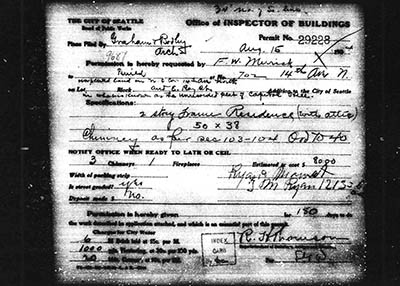
Building Permit
The original permit from 1904.
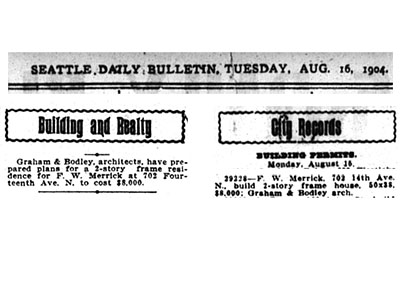
Permit Announcement
The permit announcement from The Seattle Daily Bulletin, August 16, 1904.
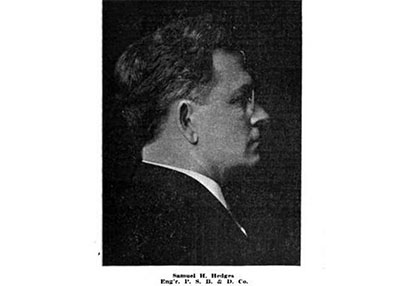
Samuel Hedges
Samuel Hedges, the houses's third resident, built big things like Harbor Island and the original Husky Stadium.

Odd Trivia
Samuel Hedges, also patented a sock that only encloses the first, third, and fifth toes.

The Architect
John Graham, Sr., one of this house's architects, designed Seattle landmarks, including the Fredrick and Nelson / Nordstrom Building, and the Dexter Horton Building.
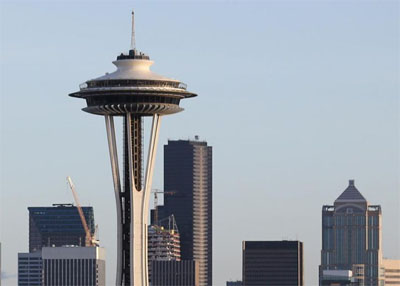
Architect's Legacy
John Graham, Sr. formed Graham & Company in 1900. His son later led the firm, and was Chief Architect of the Space Needle.
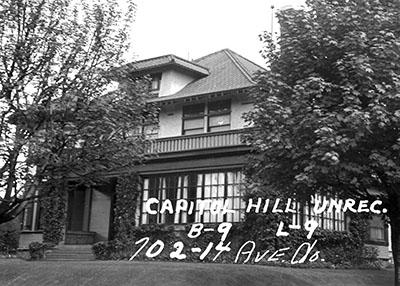
Archive Photo
This 1937 photo is from the Washington State Archives.
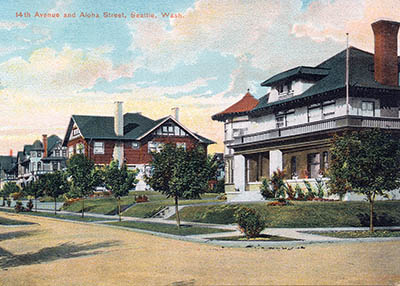
Vintage Postcard
Looking north on 14th from Roy, the houses pictured here are (right to left) the Hedges House, the Stuart House and the Bordeaux House.

Capitol Hill Inventory
Nyberg and Steinbrueck's 1975 Inventory cited this house as significant to the Capitol Hill community

Book Cover
This house was illustrated for the cover of the 2007 book, Hannah West on Millionaire's Row